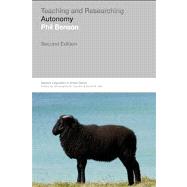
Note: Supplemental materials are not guaranteed with Rental or Used book purchases.
Purchase Benefits
Looking to rent a book? Rent Teaching and Researching: Autonomy in Language Learning [ISBN: 9781408205013] for the semester, quarter, and short term or search our site for other textbooks by Benson; Phil. Renting a textbook can save you up to 90% from the cost of buying.
Phil Benson is a Professor in the Department of English at the Hong Kong Institute of Education. He has published widely on autonomy and narrative research and is now pursuing interests in second language identities and popular culture and education.
General Editors’ Preface
Author’s Acknowledgements
Introduction
Section I: What is autonomy
1 The history of autonomy in language learning
1.1 Origins of the concept
1.2 Autonomy and self-access
1.3 Autonomy and learner training
1.4 Autonomy and individualisation
1.5 Autonomy and interdependence
1.6 Why autonomy? Why now?
1.7 The two faces of autonomy
2 Autonomy beyond the field of language education
2.1 Educational reform
2.2 Adult education
2.3 The psychology of learning
2.4 The philosophy of personal autonomy
2.5 Autonomy in language learning and its sources
3 Defining and describing autonomy
3.1 Dimensions of autonomy
3.2 Versions of autonomy
3.3 Measuring autonomy
3.4 Autonomy and culture
4 Control as a natural attribute of learning
4.1 Self-management in learning
4.2 Learner agendas in the classroom
4.3 Control of psychological factors influencing learning
4.4 The seeds of autonomy
5 Dimensions of control
5.1 Control over learning management
5.2 Control over cognitive processing
5.3 Control over learning content
5.4 Describing the autonomous learner
6 Conclusion
Section II: Autonomy in practice
7 Fostering autonomy
8 Resource-based approaches
8.1 Self-access
8.2 Tandem learning
8.3 Distance learning
8.4 Self-instruction
8.5 Out-of-class learning
8.6 The effectiveness of resource-based learning
9 Technology-based approaches
9.1 Computer-assisted language learning
9.2 The Internet
9.3 The effectiveness of technology-based approaches
10 Learner-based approaches
10.1 Learner development and language learning
10.2 Learner development and autonomy
10.3 The effectiveness of learner-based approaches
11 Classroom-based approaches
11.1 Planning classroom learning
11.2 Evaluating classroom learning
11.3 The nature of control in the classroom
11.4 The effectiveness of classroom-based approaches
12 Curriculum-based approaches
12.1 The process syllabus
12.2 Examples of curriculum-based approaches
12.3 The effectiveness of curriculum-based approaches
13 Teacher-based approaches
13.1 Teacher roles
13.2 Teacher autonomy
13.3 Language advising
13.4 Teacher education
13.5 The effectiveness of teacher-based approaches
14 Conclusion
Section III: Researching Autonomy
15 Research methods and key areas of research
15.1 Teachers’ research
15.2 Key areas of research
16 Case studies
16.1 Case study 1. Out-of-class learning
16.2 Case study 2. Self-organised language learning
16.3 Case study 3. The discourse of language advising
16.4 Case study 4. Self-directed learning in the classroom
16.5 Case study 5. Language acquisition in autonomous classrooms
16.6 Case study 6. What do good independent learners do?
17 Conclusion
Section IV: Resources
18 Resources for research and practice
18.1 Books, journals and newsletters
18.2 Conferences and workshops
18.3 Professional associations
18.4 E-mail lists
18.5 Web sites
18.6 Bibliographies
18.7 Self-access centres
References
Index
The New copy of this book will include any supplemental materials advertised. Please check the title of the book to determine if it should include any access cards, study guides, lab manuals, CDs, etc.
The Used, Rental and eBook copies of this book are not guaranteed to include any supplemental materials. Typically, only the book itself is included. This is true even if the title states it includes any access cards, study guides, lab manuals, CDs, etc.